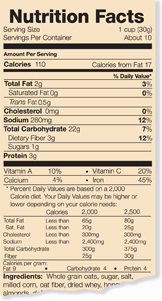Note on the food label shown in Figure 30–9 that fat contains about 9 Calories per gram, while carbohydrate and protein contain 4 Calories per gram. Why the difference? The carbon atoms in fats generally have more C–H (carbon to hydrogen) bonds than the carbon atoms in carbohydrates or proteins. Oxidizing these C–H bonds releases a great deal of energy. Because of this, oxidizing a gram of fat releases more energy than does oxidizing a gram of protein or carbohydrate, giving fats a greater energy value in Calories per gram.
When using food labels, it is important to remember that Percent Daily Values are based on a 2000-Calorie diet. However, nutrient needs are affected by age, gender, and lifestyle. The daily energy needs of an average-sized teenager who exercises regularly are about 2200 Calories for females and about 2800 Calories for males. People who are more active than average have greater energy needs. When a person stops growing or becomes less active, energy needs decrease.
Maintaining a Healthful Weight Inactive lifestyles and high-Calorie diet are contributing factors to the growing rate of obesity in the United States during the last several decades. Exercising about 30 minutes a day and eating a balanced diet can help maintain a healthful weight. Regular physical activity helps to maintain a healthful weight by burning excess Calories. Other benefits of physical activity include strengthening of the heart, bones, and muscles.
The American Heart Association recommends a diet with a maximum of 30 percent of Calories from fat, of which only 7 percent should be from saturated fats and 1 percent from trans fats. Controlling fat intake is important for several reasons. Foods that contain a high amount of any type of fat are high in Calories. A diet high in saturated fats and trans fats increases the risk for developing heart disease, Type II diabetes, or both.

FIGURE 30–9 Food Label Reading food labels can help you track how many Calories you consume in a day and if you are meeting your requirements for important nutrients.
30.2 Assessment

-
Review What are the two reasons humans need to eat?
Infer Foods that contain many Calories but few raw materials are said to contain empty Calories. What do you think the phrase empty Calories means?
-
Review List six nutrients that the body needs.
Compare and Contrast How are saturated and unsaturated fats similar? How are they different?
-
Review How can food labels be used to plan a balanced diet?
Calculate One serving of a particular food contains 16 g of carbohydrates, 2 g of protein, and 10 g of fats. Approximately how many Calories does it contain?

ANALYZING DATA
Examine Figure 30–9 and answer the questions.
-
Calculate If you ate 2 cups of this product, how many grams of fat would you eat? How many total Calories would you eat?

Evaluate This product's packaging advertises that it contains 0 g of trans fat. Does that mean the product contains no trans fat? Explain.

Table of Contents
- Formulas and Equations
- Applying Formulas and Equations
- Mean, Median, and Mode
- Estimation
- Using Measurements in Calculations
- Effects of Measurement Errors
- Accuracy
- Precision
- Comparing Accuracy and Precision
- Significant Figures
- Calculating With Significant Figures
- Scientific Notation
- Calculating With Scientific Notation
- Dimensional Analysis
- Applying Dimensional Analysis




